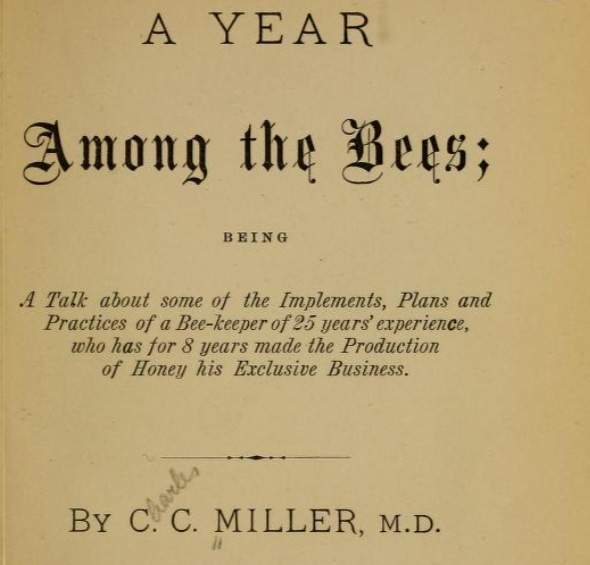November can be a cold month in many parts of the world. That is true here in the UK as well as in many parts of the US. In this month’s historical advice for beekeepers, we look at a memoir and advice book for beekeepers, published from 1886 through 1911 by C.C. Miller. The book offers various biographical accounts as well as genuine practical guidance for beekeepers but is specific to the colder winters of the countryside in Ohio.
The advice is simple: bring the bees inside so that they do not freeze to death during the harsh winters. In fact, there isn’t much more about November than this, but it nonetheless offers an opportunity to take a glimpse at another historical book about beekeeping (and perhaps a starting point for more essays in the future about Miller’s memoir).
“In visiting and talking with other bee-keepers I am generally prejudiced enough to think my plans are, on the whole, better than theirs, and yet I am always very much interested to know just how they manage, especially as to the little details of common operations, and occasionally I find something so manifestly better than my own way, that I am compelled to throw aside my prejudice and adopt their better way.”
The American beekeeper, C. C. Miller introduced his 1886 book A Year Among the Bees, by ruminating on the nature of beekeepers and admitting that most think their way is best (and often it is the best for them), even when it completely contradicts what another beekeeper is doing.
There is something very familiar about this claim and I suspect there are a lot of beekeepers who see this among those in their local association. There truly is no single way to keep and manage bees; it was and continues to be, a craft that requires constant experimentation and exploration and is often very individualised.
Miller’s A Year Among the Bees was far from his last word about beekeeping. He enlarged it in 1903 as Forty Years Among the Bees, and then again in 1911 as Fifty Years Among the Bees. He first took up beekeeping after studying medicine (and then deciding that it wasn’t right for him), then taught music at a school. He became a beekeeper in July 1861 when he and his wife caught a swarm. In 1866 they obtained their first Italian queen and by 1867 were able to make a small profit. Two years later Miller subscribed to the newly started American Bee Journal and started to experiment with different types of bee hives, honeycomb frames, and other equipment such as honey extractors.
His first account of his beekeeping adventures was therefore published 25 years after he first gathered a swarm and within its contents is a small passage specific to November. Here Miller talked about wintering the bees in the cellar as it was too cold for them outside. This of course caused problems, most particularly the need to bring his colonies home by the 1st November, potentially losing some of the potential foraging that the bees could have obtained in these last few days of relative warmth. This is what Miller wrote:
In the fall, the bees must be brought home from the out apiary so as to be wintered in the cellar. If I were in a latitude where out-door wintering was safe, I should be glad to leave them the year round without moving.
I have studied somewhat upon some plan by which they might be safely left, and am not without hope that sometime cellar wintering may be so perfected that I can build at little expense a cellar for each out apiary where the bees may be left without attention from fall till spring. I have not reached that point yet, so I feel obliged to have all my bees brought home in the fall.
There are always a few things upon which bees can work till quite late; so it is desirable to be as late as possible bringing them home. They must, however, be brought home early enough so they will be sure of a good flight after being brought home, and before being put into the cellar.
For the past five years ending with 1885, I have begun putting bees into the cellar from Nov. 4 to as late as Nov. 13. This makes it necessary to have the bees hauled home by about Nov. 1.
Miller moved around during his time as a beekeeper. When he wrote these words he was living in the country near Cincinnati. Winters were cold and summers were hot, thus the need to winter bees inside.
In his 1911 edition, Fifty Years Among the Bees, Miller added that he had tried to bring the bees inside in late October one year, but ‘the bees decided they would not be taken in, and whenever I attempted to take them in they boiled out’.
This advice was, of course, only useful for those in colder winter climates but is interesting for the experimentation that Miller did on exactly when it was best to bring the bees in. Too soon and the bees would be deprived of useful foraging (and might try to break free). Too late and the bees might already suffer from the cold.
Source
Miller, C.C., A Year among the Bees; being A Talk about some of the Implements, Plans and Practices of a Bee-keeper of 25 years’ experience, who has for 8 years made the Production of Honey his Exclusive Business (Chicago, 1886), pp. 99-100.




